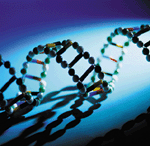 |
|
|
| ||
|
Talking with biologists The language of life is written in a four-letter alphabet - A, C, G and T - that was jointly deciphered by physicists and biologists, but since the discovery of the double-helix structure of DNA almost 40 years ago, physicists and biologists have gone on to develop their own, quite distinct languages and vocabularies. However, the last few years have seen significant efforts to rekindle productive collaborations between the physics and biology communities, such as the workshop on "DNA and its interactions" organized by the Wellcome Trust - the biomedical research charity - and the Institute of Physics last month. (A report of this meeting will appear in next month's issue.)
So how can physicists and biologists work together? Progress would seem possible on two broad fronts - conceptual and experimental. Physicists have contributed to major conceptual leaps in biology before, but it is important for today's physicists to realize that their predecessors who won Nobel prizes for physiology or medicine - such as Max Delbrück and Francis Crick - did not just dabble in biology or make major discoveries by accident. Rather they immersed themselves in their new subject. Similarly, today's biologists have adopted a plethora of techniques and instruments from physics - such as synchrotron radiation and nuclear magnetic resonance - and are doing very nicely, thank you. They are not just looking for any old physics technique but for those that will make a real difference to their research. For instance, biologists need to be able to follow events inside cells, such as the replication of chromosomes and the folding of proteins, in real time. Physicists have already made tremendous progress in exploring the mechanics of single molecules of DNA, but repeating this inside a living cell is much more difficult. And there are still major challenges in mature areas of biology - many proteins are difficult or impossible to crystallize, and the "phase problem" has still not been solved in X-ray crystallography. But the flow is not all one way from physics into biology: DNA is a remarkable material that is being explored by increasing numbers of physicists; and there is some interesting physics at work inside the ear (see article). Physicists and biologists differ most in their attitudes to theories of everything. While the majority of physics researchers are not directly involved in the search for a unified theory of all the forces, they are united in their belief that the physical world can be described by general laws and universal principles, and that these are more important than the detail. Biologists and biology are different: with the exception of evolution, there are few general principles and the detail is all important. However, the conceptual approach favoured by physicists could yield dividends when applied to specific problems in biology (such as protein folding). Robert May, the physicist-turned-biologist who is now president of the Royal Society, once said that the biggest challenges in biology, such as understanding the genome, are still in a "Tycho Brahe phase" of describing and cataloguing phenomena. The challenge was, he said, to move first into the Keplerian era - which is characterized by a phenomenological approach - and then on to a deeper understanding in a "Newton phase". Physicists who choose to join in this effort face a steep learning curve and a barren period with few, if any, publications. But by working with the right biologists, it could well be worth the effort. Here we go - again Is it really only four years since the captain of the Brazilian football team graced the cover of Physics World? With the 2002 World Cup approaching - and with new data on how the drag force on the ball varies with velocity - we revisit the vexed question of the physics of the banana kick (see summary). Goalkeepers beware!
|
| ||||||||||||||||||||||||||||||||||||||||||||||||||||||||||||||||||||||||||||||||||||||||||||||||||||||||||||||||||||||||||||||||||||||||||||||||||||||||||||||||||||||||||||||||||||||||||||
|
Home | News | Physics World | PhysicsJobs | Resources | Events Tel +44 (0)117 929 7481 | Fax +44 (0)117 925 1942 | E-mail info@physicsweb.org | ||||||||||||||||||||||||||||||||||||||||||||||||||||||||||||||||||||||||||||||||||||||||||||||||||||||||||||||||||||||||||||||||||||||||||||||||||||||||||||||||||||||||||||||||||||||||||||||
